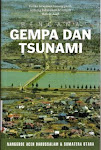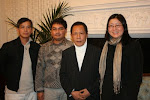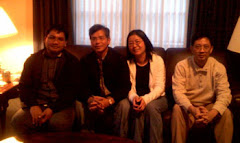Nostra Aetate and Beyond:
Toward a Non-Imperialistic Paradigm in Inter-Religious Dialogue
By Patrisius M. Andalas
Islam’s attitude to Christianity is as old as Islam itself.
Fazlur Rahman[1]
His Holiness’ address at
I discuss the problem of building a non-imperialistic paradigm in inter-religious dialogue between Catholics and Muslims from three different perspectives. Firstly, I revisit Nostra Aetate and other second Vatican Council documents to understand her true identity as a world Church living with the religious others. Secondly, I use the experiences and reflections of
Revisiting Nostra Aetate
Nostra Aetate, a progressive document written by the Second Vatican Council, addresses the Catholic attitude toward the religious others. The document considers the importance of inter-religious dialogue, but it seems not to anticipate that proclamation might interfere with other religious communities. The Catholic Church proclaims the Gospel to people who belong to other faith communities and her failure to harmonize evangelization and inter-religious dialogue potentially creates a situation of religious intolerance. Christian evangelization often creates fear among the Muslim community and they respond to it instinctively by proclaiming Allah (da’wa) with similar attitude.
Nostra Aetate represents perhaps the first progressive Catholic appreciation of Islam and of the Muslim community. The document examines initially only Catholic attitudes toward Judaism and only later terms its attitude toward other religions, including Islam. Nostra Aetate marks a new consciousness that the Catholic Church lives side by side with the religious others. It promotes love and unity among religious believers from the Catholic perspective. The new world characterized by interrelation between its habitants from different settings was born. Sincere respect is the basic attitude of the Catholic Church encountering other faith communities. She encourages her sons to build dialogue and collaboration with the followers of other religions.
Nostra Aetate approaches the Muslim community respectfully and lovingly. It recognizes that they call themselves Muslims because they submit their lives to the one God. It acknowledges that they respect Abraham, Jesus, and Mary. It also recognizes that they also wait for the judgment day. They show their submission to God especially by praying, almsgiving and fasting. The document’s appreciation for Islam should not lessen the Church’s call to announce the saving truth of Christianity. Her mission obliges her to shed the light of the Gospel message on the whole world and to gather all men and women in the one Spirit.[2]
The Church regards with esteem also the Moslems. They adore the one God, living and subsisting in Himself; merciful and all- powerful, the Creator of heaven and earth,(5) who has spoken to men; they take pains to submit wholeheartedly to even His inscrutable decrees, just as Abraham, with whom the faith of Islam takes pleasure in linking itself, submitted to God. Though they do not acknowledge Jesus as God, they revere Him as a prophet. They also honor Mary, His virgin Mother; at times they even call on her with devotion. In addition, they await the day of judgment when God will render their deserts to all those who have been raised up from the dead. Finally, they value the moral life and worship God especially through prayer, almsgiving and fasting.
Since in the course of centuries not a few quarrels and hostilities have arisen between Christians and Moslems, this sacred synod urges all to forget the past and to work sincerely for mutual understanding and to preserve as well as to promote together for the benefit of all mankind social justice and moral welfare, as well as peace and freedom.[3]
This statement on Islam learns reflectively the past Church’s experiences of dealing with the Islamic community. She misunderstood Islam and quarreled with the Muslim community. Nostra Aetate calls the Catholic Church to understand Muslims and to collaborate with them better. Mutual misunderstandings in the past caused unnecessary quarrels that still leave a negative mark on both parties. The Catholic Church hopes that sincere understanding will create a new era in her relationship with the Muslim community. She also opens herself to collaborate actively Muslims to preserve and promote social justice, moral welfare, peace, and freedom.
According to Nostra Aetate, the Catholic Church respects other religious communities who proclaim their distinctive faiths, but proclaims Christ as the “Way, Truth, and Life.”[4] She believes that God reconciles men and women through Jesus and that they find fullness in Christ. She does not anticipate conflict when she proclaims the Gospel while other faith communities proclaim their belief. Inter-religious dialogue and proclamation of Christ can both advance without tension. She promotes the possible conflict when she associates Catholicism with “the true God” and other religions with “preparation for the Gospel.” She proclaims that Christ comes to the world to heal and perfect religious values.
Ad Gentes, Vatican II’s decree on mission activity in the Church, portrays her as a sacrament for universal salvation. God sends her to proclaim and establish the Reign of God throughout the world. The missionary Church encounters worlds that challenge her to re-imagine her role as the salt and the light of the world.[5] God sends her urgently to redeem and renew every creature, and to build one family in God and one people of God.[6] The missionary Church recognizes her status as a pilgrim. She also has a missionary nature because as a pilgrim she seeks to gather all people into the family of God.[7] God calls her to enlighten and to heal them and to restore their communion with God and their fellow human beings. The day of Pentecost transforms the newly born into a servant of Christ sent to “supersede the divisiveness of
The Catholic Church sends her heralds of the Gospel to the whole world to preach the Gospel and to plant the Church among peoples who do not yet believe in Christ. She distinguishes pastoral activity that restores unity among Christians from missionary activity that promotes unity with all people still outside the Church. Her missionary activity derives its reason from the will of God, "who wishes all men [and women] to be saved and to come to the knowledge of the truth. For there is one God, and one mediator between God and men, Himself a man, Jesus Christ, who gave Himself as a ransom for all" (1 Tim. 2:45), "neither is there salvation in any other" (Acts 4:12). She receives a sacred duty from God to teach the Gospel, convert and baptize unbelievers. They will not receive salvation if they do not listen to the Gospel and allows themselves to receive baptism, and join the Catholic Church.[9]
The Catholic Church include all religious others as the hearers of her evangelization. She proclaims to all peoples the living God who saves their sinful humanity through Jesus. Jesus sends her to reveal and communicate the love of God to humanity. She proclaims the Catholic faith with confidence and constancy, but strictly forbids forcing anyone to embrace it.
The Church, sent by Christ to reveal and to communicate the love of God to all men and nations, is aware that there still remains a gigantic missionary task for her to accomplish. For the Gospel message has not yet, or hardly yet, been heard by two million human beings (and their number is increasing daily), who are formed into large and distinct groups by permanent cultural ties, by ancient religious traditions, and by firm bonds of social necessity. Some of these men are followers of one of the great religions, but others remain strangers to the very knowledge of God, while still others expressly deny His existence, and sometimes even attack it. The Church, in order to be able to offer all of them the mystery of salvation and the life brought by God, must implant herself into these groups for the same motive which led Christ to bind Himself, in virtue of His Incarnation, to certain social and cultural conditions of those human beings among whom He dwelt.[10]
Conversion without “Conversion”
The Catholic Church in
In the second Vatican Council, the Catholic Church identifies herself as a world Church. She broadens her horizon beyond
Although Vatican II seems to portray missionary work seems to be a major activity in the Catholic Church, it has secondary importance in the Church as a whole. The Vatican II Council clearly portrays missionary work as an inherent activity of the Church. At the same time, the Council sees other religions more positively. It recognizes the possibility of salvation outside the Catholic Church. At the same time she realizes that she needs to proclaim Christ to the world. Pastoral work targets the Catholic community, and ecumenical work targets non-Catholic Christians, both evangelization and inter-religious dialogue target non-Catholic Christians in Vatican II. At the same time, the Church lacks a clear understanding of evangelization.
When the Asian delegates returned home from the Second Vatican Council, the new global reality of the Catholic Church confronted a specific local context. That context forced a re-interpretation of the approach to evangelization in the Vatican II. The Federation of Asian Bishops’ Conference (FABC) took shape in that context.[11] Asian realities led the Asian Catholic bishops to put dialogue at the heart of evangelization. We need to evangelize through dialogue with cultural pluralism and poverty in its diverse Asian forms. Dialogue, in other words, holds key for evangelization. This novel discovery influences the way Asian Catholic churches understand themselves and others. The new evangelization refuses to isolate, dominate, or treat triumphalistically the non-Catholic communities. Dialogic evangelization respects Asian realities.
Dialogue with other religions has become a conditio sine qua non for the Asian churches. The Federation of Asian Bishops’ Conference (FABC) wants evangelization suggests us to begin with dialogue of life rather than a priori theological discourse. The initial dialogue does not seek to convert non-Catholics to the Catholic Church. It seeks a conversion of life. It promotes living in harmony with respect for other religious communities. The Catholic Church in
The dialogic approach to other religions also raises questions for Catholic communities outside
The Indonesian Bishops’ Conference, for instance, explicitly challenges the
The Indonesian Bishops’ Conference recommends all Catholic churches to know other religions and to have living contact with their adherents. Catholics and Muslims, for instance, understand each other primarily through a dialogue of life. Their religious leaders meet with each other, as Vatican II recommended, in order to solve social problems together. Not all Muslims welcome such contact. Some Muslim groups declare fatwa that prohibits their adherents from relate with Catholics. They tend, as a result, to impose Islamic values on other religious minorities. Islamic da’wa, funded by international support, often threatens Catholics who live with a Muslim majority. Then, mutual incomprehension and prejudice often prohibit close association. The Catholic Church in
In his response to John Paul II’s encyclical Ecclesia in Asia, Michael Amaladoss an Indian Catholic theologian, suggest a new paradigm in Catholic evangelization in
Michael Amaladoss regards God as the primary agent in evangelization and the Catholic Church as the servant of that God. God saves, and all religious communities mediate the saving action of God. The Catholic Church participates in that saving process by symbolizing and serving the
He warns against the
Resisting an Imperial Attitude
Seyyed Hossein Nasr strongly criticizes modern Western Christians for misconceiving Islam as a religion of violence. They contrast Islam with Christianity, which they portray, as a religion of civilization and ignore about the crusade. They oversimplify history by conceiving the prophet Muhammad as a man of war and Jesus as a man of peace. They ignore the Prophet’s role as a prophet of peace as well as political leader. In fact, both the Islamic ummah and the Catholic Church have struggled to build religious civilizations. Christianity has sanctioned wars in the name of religion. Like Christianity, Islam regulates war in order to limit it, not because it is a religion of sword.[13]
Carl W. Ernst criticizes both Christianity and Islam for having acted as imperialistic religions in their attempts to convert the world. Both have succumbed to religious fundamentalism which excludes or eliminates religious others of a different point of view. Inter-religious dialogue can never happen when one religion seeks to dominate the religious others. Historical and cultural study of attitudes toward Islam can help Christians to acknowledge their anti-Islamic attitudes from the middle ages to the present.[14] Fear of Arab conquest, of course, fed those attitudes.
The Qur’an depicts religious pluralism as part of the divine plan.
For everyone we have established a law and a way. If God had wished, he would have made you a single community, but this was so he might test you regarding what he sent you. So try to be first in doing what is best.[15]
Muslim societies have in fact to institutionalize religious pluralism. They have defined the status of religious minorities in constitutions and legal codes. They have sought to protect religious minorities from religious intolerance. Islamic Law explicitly requires Muslims to protect Jews and Christians, and it implicitly requires protection of other religious minorities (dimmi) by enabling them to live, own property, and practice their religious beliefs.
Muhammad and his followers consider both Jews and Christians as people of the Book (ahl al-kitab). They recognize and venerate both Jewish and Christian prophets. They consider Jesus as the Word of God (kalimatu-llah). They believe that Judaism, Christianity, and Islam have a common religious origin. The religious split between the three religions happened at the end of the
In
And we have sent down to you the Book in truth, confirming the Book that existed already before it and protecting it…. For each one of you We have appointed a Law and a Way of Conduct. If God had so willed, He would have made all of you one community, but that He may test you in what He has given you; so compete in goodness. To God shall you all return and He will tell you about what you have been disputing.[17]
Intolerance or persecution of other religious minorities happens when Muslim community adopts the imperial attitude of the colonial era. An imperial attitude creates conflict by dividing the world into “us” versus “them.” A religious community that adopts this attitude treats other religious communities as potential threats to its imperial power. It always repudiates religious others and demands their submission. Ernst warns the Muslim community against the danger of persistent, historical imperial attitudes then permeates religious institution. The imperial attitude in Islam will lead to view religious others as objects of conquest.[18]
A non-imperialistic Christian approach to Islam attempts to re-imagine Islam. Such an approach avoids stereotyping both communities. Muslims need to cultivate a similar approach. Muslim fundamentalists who declare war against Western civilization cling to an imperialistic approach to the world. Christian fundamentalists who declare war against Islamic barbarity and idolize Western civilization as the only true civilization, also cling to religious imperialism.
The Prophet Muhammad regarded God as the source of unity among the diverse religions. He also struggled to deal with the problem of religious diversity within Islam.[19] Khaled Abou El-Fadel believes that the Islamic ummah has continued to follow the Prophet in protecting the religious minorities and in considering them as genuine religious communities. The Islamic imperialists remain sociologically and intellectually marginal in Islam. Muslim imperialists twist Islamic texts to justify their religious intolerance. [20] I refer to texts like the following
“O You who believe, do not take Jews and Christians as allies. They are allies of each other, and he amongst you who becomes their ally is one of them. Verily, God does not guide the unjust.”[21]
“Whomsoever follows a religion other than Islam this will not be accepted from him, and in the Hereafter he will be among the losers.”[22]
“Fight those among the People of the Book (Jews and Christians) who do not believe in God or the Hereafter, who do not forbid what God and His Prophet have forbidden, and who do not acknowledge the religion of truth – fight them until they pay the poll tax (jizyah) with willing submission and feel themselves subdued.”[23]
The Qur’an clearly claims that Islam believes divine truth, and demands belief in Muhammad as the final messenger in a long line of Abrahamic prophets, but it does not completely exclude the possibility of other paths of salvation. It prohibits any form of coerced conversion to Islam. It holds a basic principle that “there is no compulsion in matter of faith.”[24] When Catholics approach Muslims with respect and love, consistent Muslims should seek to make peace with them.
Re-reading Pope Benedict’s Address with a Peaceful Heart
At the end of this essay, I return to the dialogue between His Holiness Pope Benedict XVI, who represents the Catholic Church, and His Royal Highness (Prince Grazi bin Muhammad bin Talal), who represents the Islamic ummah. Muslim scholars, in their Open Letter to His Holiness Pope Benedict XVI, correct His Holiness because of he misunderstands Islam. The exchange between the Emperor Manuel II Paleologus and a “learned Persian” contradicts Islamic attitudes toward religious others, especially Catholics. He never used his political power to convert people violently. It contradicted his faith to proclaim a merciful God with the sword. Islam is a religion of peace that does not prescribe violent religious conversion.[25]
The Muslim scholars also correct His Holiness of his misconceiving jihad. They seem do not recognize that Benedict spoke as a German scholar citing a quotation from history to which his speech looks exception. Jihad means not war, but struggle in the way of God. Hatred for the religious others contradicts Islamic faith. The Prophet never forced conquered populations to convert into Islam. He protected them legally so that they could continue practice their religious faith. They became Muslims because of peaceful da’wa, not through forced conversion.[26] The prophet envisioned an Islamic society that welcomes the religious others to live side by side peacefully. He protected the religious minorities legally in order to guarantee their religious freedom.
The Muslim scholars wrote with openness. They call for a common commitment to promote peace in the world. The
“…We must not yield to the negative pressures in our midst, but must affirm the values of mutual respect, solidarity, and peace. The life of every human being is sacred, both for Christians and for Muslims. The life of every human being is sacred, both for Christians and for Muslims. There is plenty of scope for us to act together in the service of fundamental moral values…”[27]
The Pope acknowledges that the Qur’an declares that Islam does not oppose Christianity. It encourages Muslims never to act against Christians. Muslims should consider Christians as their brothers and sisters. They should respect Jesus as the Word of God. They should encourage Christians to recognize Islamic and Christianic commonality. Muslims and Christians both worship one God and fight against idolatry or proselytism. Inter-religious dialogue between Muslims and Christians could make a major contribution to the world peace. Religious diversity should not separate two communities. It should rather challenge them to see God as the source of unity between religious communities.[28]
Say (O Muslims): We believe in God and that which is revealed unto us and that which was revealed unto Abraham, and Ishmael, and Isaac, and Jacob, and the tribes, and that which Moses and Jesus received, and that which the prophets received from their Lord. We make no distinction between any of them, and unto Him we have surrendered. / And if they believe in the like of that which ye believe, then are they rightly guided. But if they turn away, then they are in schism, and God will suffice thee against them. He is he Hearer, the Knower.[29]
Two open letters sent by the Moslem scholars, who hopefully represent the World Muslim community, point out that the Catholic Church represented by His Holiness Benedict XVI needs to re-imagine Islam. The Catholic Church should revisit Nostra Aetate and other
The
The Catholic Church re-imagines herself as a religious community in dialogue with the religious others. She discovers that she used to become an imperializing force that imposed uniformity. The divine revelation and action only took place through her institutional body. She imagined herself as an Empress who demanded eternal submission from her conquered territories. She should return to her original identity as a religious community whose missionary approach is not monologue, but dialogue. She will listen to the mystery of God that works through the religious others before she proclaims the Gospel.[30] An imperialistic approach toward other religious communities disqualifies the truth and validity of divine revelation that takes place outside her body. On the contrary, a dialogical approach toward the religious others invite the Catholic Church to recognize the divine act in other religious communities and respect it. Finally, it is time for all Catholic and Islamic communities to shift their prevailing imperialistic paradigm into a dialogical one for a better inter-religious dialogue in the future.
Bibliography:
Amaladoss, Michael. Beyond Inculturation: Can the Many be One?
An Open Letter of 38 Scholars to His Holiness Pope Benedict XVI
An Open Letter and Call from Muslim Religious Leaders to His Holiness Pope Benedict XVI and leaders of
Arkoun, Mohammed. Rethinking Islam: Common Questions, Uncommon Answers. Translated and edited by Robert D. Lee.
Ayoub, Mahmoud. A Muslim View at Christianity: Essays on Dialogue.
Budi, J. Hartono and M. Purwatma (Eds.), Sentire Cum Ecllesia: Bakti Membangun Gereja yang Hidup.
El Fadel, Khaled Abou et all. The Place of Tolerance in Islam.
Ernst, Carl W. Following Muhammad: Rethinking Islam in the Contemporary World. Chapel Hill: The
Knitter, Paul F. No Other Name? A Critical Survey of Christian Attitudes toward the World Religions.
Nasr, Seyyed Nossein. Islamic Life and Thought.
_____. Ideals and Realities of Islam. Revised Edition.
Neuner, J. and J. Dupuis, The Christian Faith in the Doctrinal Documents of the Catholic Church.
Phan, Peter P. The Asian Synod: Text and Commentaries.
Pope Benedict XVI. Faith, Reason, and University: Memories and Reflection
Fazlur Rahman, Fazlur. Major Themes of the Qur’an.
Sugirtharajah, R.S. Asian Faces of Jesus.
[1] Fazlur Rahman, Major Themes of the Qur’an (Minneapolis: Biblioteca Islamica, 1994), 162.
[2] Gaudium et Spes, 28. 92.
[3] Nostra Aetate, 3.
[4] John 14, 6.
[5] Matt. 5, 13 – 14.
[6] Ad Gentes, 1.
[7] Ad Gentes, 2.
[8] Ad Gentes, 4.
[9] Ad Gentes, 7.
[10] Ad Gentes, 11.
[11] The Federation of Asian Bishops' Conferences (FABC) is a voluntary association of episcopal conferences in South, Southeast, East and
[12] Peter C. Phan, Ed., The Asian Synod: Texts and Commentaries (
[13] Seyyed Hossein Nasr, Ideals and Realities of Islam, revised edition (London: Unwin Hyman, 1988), 31 – 32. 71.
[14] Carl W. Ernst, Following Muhammad: Rethinking Islam in the Contemporary World (Chapel Hill: The
[15] Qur’an 5, 48.
[16] Fazlur Rahman, Major Themes of the Qur’an, 162 – 167.
[17] Qur’an 5, 48.
[18] Carl W. Ernst, Following Muhammad, 203 – 208.
[19] Ibid, 164.
[20] Khaled Abou El Fadel et al., The Place of Tolerance in Islam (
[21] Qur’an 5, 51.
[22] Qur’an 3, 85.
[23] Qur’an 9, 29.
[24] Qur’an 2, 56; 10, 99; 18, 29.
[25] Open Letter to His Holiness Pope Benedict XVI, 1.
[26] Ibid, 2.
[27] His Holiness Pope Benedict XVI, Address to the Representatives of Some Muslim Communities,
[28] An Open Letter and Call from Muslims Religious Leaders to Leaders of
[29] Al Baqarah 2, 136 – 137.
[30] Michael Amaladoss, Beyond Inculturation: Can the Many be One (Delhi: ISPCK, 1998), 47.




















2 comments:
Mo, paper ini dikirim saja ke jurnal yach. Oh ya ada yang nanyain Romo di blog saya (posting soal buku itu).
wah... ke jurnal mana ya? soale belum kepikiran
soal buku apa ya? saya tak ke blog kamu deh....
sorry baru baca message kamu sekarang....
Post a Comment